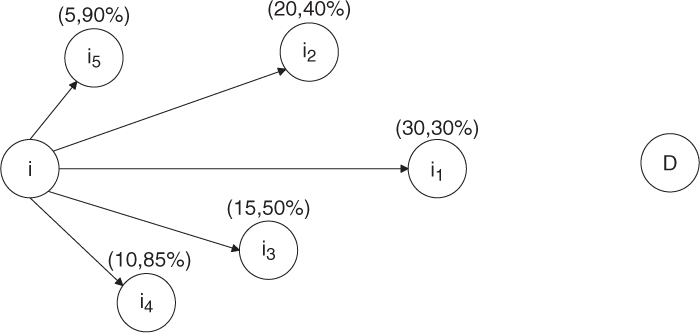3.1.1 Energy Consumption Model
Here we do not assume the promiscuous mode in which every node “overhears” the transmission within its range. Instead, being energy efficient, we assume nodes/sensors only listen to the transmissions intended for themselves. To achieve this, a second low-power radio (Vaidya and Miller 2005) can be used to wake up nodes that should participate in the EGOR or to inform the neighbors (including nodes giving negative advancement), which are not selected as forwarding candidates to shut down their data radios. Nodes can also only read the headers of packets for early rejection (Seada et al. 2004). For simplicity, we also ignore the energy consumption of the control packets,1 as control packets are usually much smaller than data packets. We only consider the energy consumption of packet transmission and reception.2 So the total energy consumption for one opportunistic forwarding attempt is:
where Etx and Erx are the packet transmission and reception energy consumption, respectively. Recall that r is the number of candidates in the forwarding candidate set ![]() .
.
3.1.2 Tradeoff Between EPA and Energy Consumption
As we proved in Lemma 2.1, the more nodes get involved in GOR, the larger the EPA can be. So the GOR that involves all the nodes in ![]() will achieve the largest EPA. This fact has been implicitly used in the existing opportunistic routing approaches. However, it is not always the most energy-efficient way to forward packets by involving all the nodes in
will achieve the largest EPA. This fact has been implicitly used in the existing opportunistic routing approaches. However, it is not always the most energy-efficient way to forward packets by involving all the nodes in ![]() . As from Equation (3.1), we know one transmission from the transmitter is accompanied by r receptions of the r forwarding candidates, so involving all the nodes in
. As from Equation (3.1), we know one transmission from the transmitter is accompanied by r receptions of the r forwarding candidates, so involving all the nodes in ![]() consumes the most energy. On the other hand, conventional geographic routing involving only one forwarding candidate has the least energy cost of one transmission and one reception but it achieves the least EPA per hop. This indicates lower routing efficiency as more hops (transmissions) might be necessary to reach the final destination. Clearly there is a tradeoff between per-hop routing efficiency and overall energy efficiency.
consumes the most energy. On the other hand, conventional geographic routing involving only one forwarding candidate has the least energy cost of one transmission and one reception but it achieves the least EPA per hop. This indicates lower routing efficiency as more hops (transmissions) might be necessary to reach the final destination. Clearly there is a tradeoff between per-hop routing efficiency and overall energy efficiency.
This tradeoff is illustrated in Figure 3.2, which corresponds to the example in Figure 3.1 by assuming Etx = 1 unit of energy, Erx = 0.5 unit. Note that although EM![]() (defined in Definition 2.1) and Et(r) are both strictly increasing function of r, the ratio
(defined in Definition 2.1) and Et(r) are both strictly increasing function of r, the ratio ![]() reaches its maximum at r = 2, and the corresponding ordered node set is 〈i1, i4〉 with node i1 having higher relay priority than i4.
reaches its maximum at r = 2, and the corresponding ordered node set is 〈i1, i4〉 with node i1 having higher relay priority than i4.
Figure 3.1 Example in which node i is forwarding a packet to a remote destination D. Reproduced by permission of © 2007 IEEE.

Figure 3.2 EM, energy cost and their ratio as functions of number of forwarding candidates. Reproduced by permission of © 2007 IEEE.

Based on the analysis above, we propose a new local metric that aims to strike a good balance between the routing efficiency and energy efficiency. The new metric is denoted as ![]() and defined in Equation (3.2) as follows.
and defined in Equation (3.2) as follows.
where Lpkt is the packet length in bits, and ![]() is defined in Equation (2.1). If the unit of
is defined in Equation (2.1). If the unit of ![]() is the meter, and
is the meter, and ![]() is the joule, the unit of
is the joule, the unit of ![]() is bmpJ. The physical meaning of
is bmpJ. The physical meaning of ![]() is the expected bit advancement to the destination by consuming 1 J of energy per packet forwarding attempt.
is the expected bit advancement to the destination by consuming 1 J of energy per packet forwarding attempt.
Now, our goal is to find a way to select a ![]() which maximizes the metric
which maximizes the metric ![]() , which can be formulated as the following optimization problem:
, which can be formulated as the following optimization problem:
where ![]() is the powerset of
is the powerset of ![]() and Sym(S) is the set of all the permutations of S. A solution to this optimization problem needs to answer the following two questions: 1. How many and which nodes should be involved in the local forwarding? 2. What priority should they follow to forward a packet?
and Sym(S) is the set of all the permutations of S. A solution to this optimization problem needs to answer the following two questions: 1. How many and which nodes should be involved in the local forwarding? 2. What priority should they follow to forward a packet?
